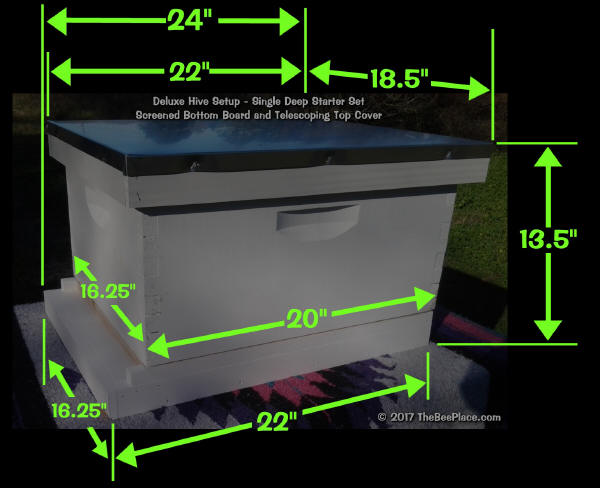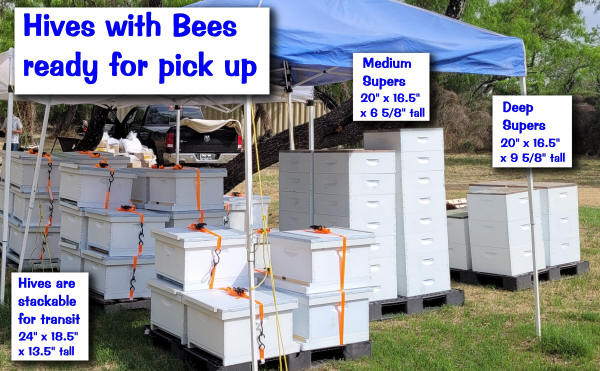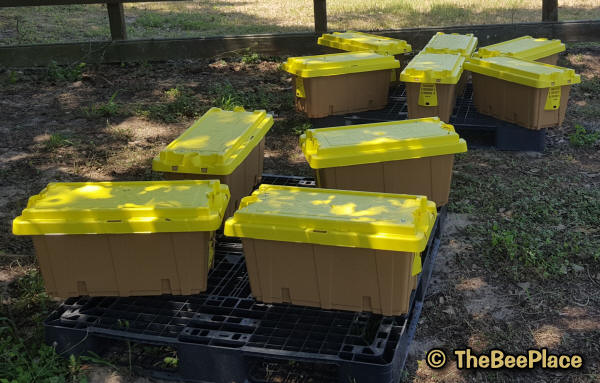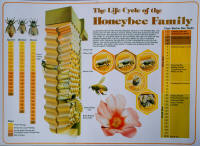|
Q: Is the queen marked?
A: No, not normally. Occasionally there will be a marked queen, but no we do not
normally mark them.
Q: Is the queen caged?
A: No, not normally. Occasionally we will provide a colony with a caged queen,
but you will be informed if that is the case and you will not need to do
anything to release her into the hives since our caged queens will have a time
release candy tube installed in the queen cage.
Q: Should I feed the bees
when I get them home?
A: Yes, a gallon of 1:1 ratio sugar syrup will get them started, then check
again weekly and feed as needed.
Q: When were these bees I bought last treated for mites?
A: The Spring bees we offer are typically treated with an Apivar strip the week we
bring them to our location where you receive the bees. The strips are an extended release
method treatment, so they are to remain in the nest for 6 weeks after you receive
them and then a follow up treatment should not be needed for 6 more weeks, total of 3 months.
(We check quarterly and treat as needed)
Even though the bees we have are VSH lines, they are still subject to the issues
associated with Varroa mites. We suggest checking using the alcohol
wash method in about 2 to 3 months and treat again if needed. Then check again
every 2-4 months - Rotate treatment methods and recheck after treatments to
insure the treatment was effective.
Q: (I bought a NUC) How long do I have
to wait to put the nuc into my hive body?
A: The bees are ready for the transfer as soon as you get them to their new
location. The ProNuc (plastic tote) is a temporary transport box designed to be
closed and move bees from one location to another with ventilation. Nucs are
ready to be installed in the
new hive the same day. We like to make the nucs on the "fat" side with plenty of
food and brood, therefore we recommend getting them into full size boxes (hives)
within a few days, otherwise they may feel over crowded and get the urge to
swarm.
There is no required waiting period. Allowing the bees to settle for
around 20 minutes then applying ample cool smoke to the bees will make the
process easier.
Q: (I bought a NUC) How long
can the bees stay closed up in the ProNuc transport tote/box?
If, for any reason, you need to keep the bees in the ProNuc box for any length
of time, they need to be kept cool and well ventilated. It is best to place the
ProNuc on top of the hive (if you have one ready) and open the sliding door to
allow the bees to fly to get food and water as soon as you reach your
destination. If you do not have a hive ready, placing the box on a stand in the exact location
where they are going to remain full time, then opening
the door will be fine and accomplish the same goal - which is to allow the bees
to keep cool and take their orientation flights to learn their new place on the
planet.
Q: (I
bought a NUC) How do I install the Nuc into my hive?
A: Start by placing your hive body in the permanent
location and removing 6 or more frames to allow plenty of room to place the 5
frames from the nuc box into your hive body. Then place the frames one by one,
keeping the same order and direction, into your hive body until all the frames
are in the center of the box. Then place the blank frames and feeder (if you
have an internal frame feeder) into the box to fill up the empty space on either
size of the frames of bees you just installed. Next, shake any remaining bees
from the transport box into your hive. This is a good time to add some sugar
syrup and close the hive top leaving the entrance open so any bees flying can
find there way inside to rejoin the colony.
Visit the
Nuc Installation page for step by step installation instructions and a 5 minute
video demonstration

Q: (I
bought a HIVE) How long do I have to wait to pull the entrance stopper/plug out
of the entrance reducer?
A: The bees are ready to get out as soon as you have
placed the hive in it's new permanent location.
Q: (I
bought a HIVE) Do I need to change the size opening on the entrance reducer part
of the bottom board?
A: Leaving the entrance reducer in the smallest (3/4")
size allows your starter colony to defend the entrance much easier than a larger
and wider entrance. Even established large population colonies are subject to
robbing activity, so a small entrance is recommended even on large hives. The
traffic will build up slightly from time to time, but this does not normally
create a problem. In the event the traffic becomes so heavy it is has bees
waiting a long time to enter.... First, make sure there is not robbing activity
at the entrance, i.e. bees fighting and rolling on the ground and entrance
landing board. If there is none, then adding small top entrance is often a
simple solution without creating any more risk of robbing.
Q: How big are the hives / what
size hive stand do I need... how much space do the hives take in my vehivle?
A: The graphics below should help for making hive
stands and/or making arrangements for loading into the space available in your vehicle.



These ProNuc boxes are 23" long x 12" wide x 11"
tall and can be stacked 3 high

Anatomy Of A Beehive

Bee Family Life Cycle
Click the images for larger views ... More helpful images below A few Do's & Do Not's - For
Picking Up Bees
What you should bring?
Bring your beekeeping gear, you may not need it, but you'll have it if you decide
you do need it once you arrive. You are coming to an apiary - a bee farm with many
hives. The entire area will potentially have a lot of bees flying throughout the
day, so protective gear is always a good idea. Meaning - Dress for the occasion.
If you ordered additional protective gear and supplies from us ahead of time, we will have it
on hand and available when you arrive. Note: We do not have a walk-in store, so
ordering supplies in advance is recommended.
The bees will be contained in the hives with the tops fastened closed for
travel. Do not leave them without air flow in the direct sun at any time, and
keep them cool and well ventilated until the bees are allowed to fly and
ventilate on their own. The containers will have ventilation to allow for air
flow to keep the bees cool during transport, but they need to be moving to
prevent overheating duiring the warmer part of the year.
Each nuc of bees, including the transport tote, can weigh up to 25 - 30 pounds,
so they are not hard to handle. The complete hives only weigh about 10 -15
pounds more, so it is up to you if you want help or not. All nucs and hives will
have the bees contained within, so they are fine in the back of a truck, in a
car or SUV. If you want to net your bees, that is fine, but due to the corona
issues, it will be up to you to put the nets on them yourself.
It is common for a few "loose bees" to be attached to the outside of the box you
will be loading. This is where they will normally stay, so allowing this does
not normally present a problem for the loose bees, nor a threat to passengers in
the vehicle.
If this is a major concern for any of the passengers, you may want to consider a
pickup truck to transport your bees, or net the boxes to be carried on the
inside of your vehicle. A simple search for "beehive transport netting" will
return multiple options. We do not provide netting for your hives, but have a
place for netting them if you bring the nets.
Securing your bees for transport:
We recommend using a ratchet strap or equivalent method to secure your bees
while in transit. Shade should be considered when stopping on the way to your
destination with your bees. Short stops for fuel are not a concern, but like any
other live animal, your bees should not be left in the direct sun or excessive
heat when they are closed up if the vehicle stops moving for long periods during
transport.
If the vehicle stops moving for extended periods, the bees will need water to
keep the hive cool, so having a spray (water) bottle could be helpful should you
have to make an unscheduled stop (flat tire, etc.) that takes longer than 30
minutes. You can mist the bees from below through the screen if needed.
|